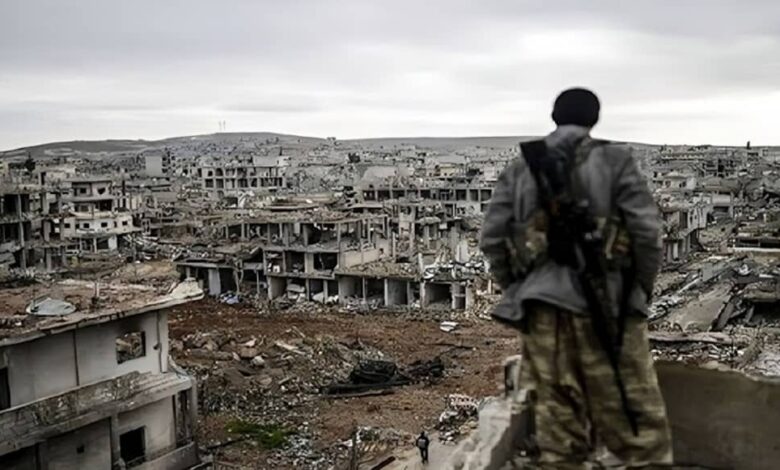Iran Encouraged Proxies’ Restraint, or Didn’t It?

- gaza destruction soldier staring
Three-minute read
Written by
Shahriar Kia
The Washington Post recently cited multiple Lebanese and Iraqi officials as saying that Tehran has been urging restraint from its proxies around the region, ever since US retaliation against those groups’ attacks began in earnest. As further support for this assessment, the article pointed to a two-week lull in those attacks, of which there had previously been more than 150 since the outbreak of war in Gaza, carried out mostly against American forces by Iraqi and Syrian militant groups.
However, these groups were operating in parallel with the similarly Tehran-backed Houthi rebels in Yemen, who have carried out around 50 attacks on commercial vessels in and around the Red Sea, as well as Western naval forces stationed in the region as a guarantor of security. In contrast to the Iraqi and Syrian groups, the Houthi have neither curtailed their belligerent activities nor announced an intention to do so, as Kataib Hezbollah did after claiming responsibility for the cross-border drone attack in Jordan which was more effective than any of its predecessors, killing three US service members and sparking the aforementioned retaliation.
At the time of that announcement, it was widely reported that Kataib Hezbollah had likely been responding to pressure from Iran. But although its attacks did stop and have not yet resumed, the announcement was reversed after one retaliatory strike killed a leader of the militant group. It was also rejected in advance by other members of the umbrella organization known as the Islamic Resistance in Iraq, which in turn is part of a region-wide coalition that the Iranian regime refers to as the “Axis of Resistance.”
#Iranian Regime’s Fourfold Objectives in the #GazaCrisishttps://t.co/UXfRouGv2b
— NCRI-FAC (@iran_policy) November 9, 2023
In one sense, Iran’s direct participation in this fight is still only a remote possibility. But in another sense, it is already happening. Last week, Vice Admiral Brad Cooper, the former head of US military forces in the Middle East, said in an interview with CBS News that members of the IRGC were on the ground in Yemen, working alongside the Houthi to plan and execute attacks on naval targets.
Cooper is by no means the first expert to hold Iran directly responsible for such attacks. Several other American and British officials have highlighted the ongoing supply of Iranian arms to the Houthi, and the US Navy recently revealed that it had captured one major shipment of drone components and other military equipment at the end of January.
On various occasions, the Iranian Resistance has released reports on IRGC weapons smuggling which highlighted its use of multiple routes and methods, as well as techniques for concealing the contents of shipments destined for Yemen and elsewhere. And just this week, the Wall Street Journal published an article describing “Iran’s rise as a global arms supplier,” adding that this phenomenon now “vexes the US and its allies.”
The article noted that even based on official sales figures, Iran has become the 16th largest arms exporter in the world, with exports valued at 123 million dollars. This, of course, excluded untold numbers of illicit sales, while both figures seem poised to grow for the foreseeable future unless significant further steps are taken by Iran’s global adversaries.
Between legitimate sales and smuggling, Iran reportedly sold one billion dollars worth of weapons in its calendar year which ran from March 2022 to March 2023, tripling its total from the previous year. Much of this is thanks to the dependency on its proxies, but much also stems from Iran’s ever-expanding relationship with Russia, with which it signed a one-billion-dollar deal last year that includes further shipments of drones for use in the Russian war on Ukraine, as well as the establishment of a factory inside Russia to produce more of the same.
NCRI Conference Exposes #IRGC Quds Force Proxy Naval Unitshttps://t.co/INQ0G6JwSG
— NCRI-FAC (@iran_policy) November 6, 2023
Iran’s military arms industry and especially the IRGC have placed much emphasis on comparatively cheap drone technology in recent years and regularly unveil or claim to unveil new models with expanded capabilities. The IRGC-affiliated Tasnim News Agency offered just such a boast on Tuesday, identifying one new “suicide drone” and one new “combat drone,” with ranges of more than 500 miles and the ability to carry heavy payloads.
While the West seems inclined towards a swift de-escalation, pinning hopes on mere firepower to address deep-rooted crises originating from strategic miscalculations in the Middle East, the situation remains far from resolved. The Iranian regime didn’t initiate a proxy war only to halt it abruptly in the face of military repercussions. The fundamental motivations that drove Tehran to instigate the conflict persist and have arguably intensified.
Consequently, the regime is confronted with a restive populace, a dispirited security apparatus, and a marginalized faction of former officials who reject the Supreme Leader’s roadmap for survival. Following the sham elections on March 1, these challenges are poised to exacerbate, compelling Tehran to reassess its approach to external crises, thereby underscoring the fallibility of the West’s assumptions once again.

